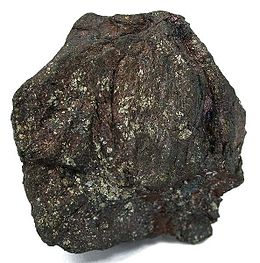Germanite
Topic: Chemistry
 From HandWiki - Reading time: 2 min
From HandWiki - Reading time: 2 min
| Germanite | |
|---|---|
 Germanite, probably from the Tsumeb Mine, Oshikoto Region, Namibia. | |
| General | |
| Category | Sulfide mineral |
| Formula (repeating unit) | Cu26Ge4Fe4S32[1] |
| Strunz classification | 2.CB.30 |
| Dana classification | 2.9.4.2 |
| Crystal system | Isometric |
| Crystal class | Hextetrahedral (43m) H-M symbol: (4 3m) |
| Space group | P43n |
| Identification | |
| Color | Reddish grey tarnishing to dark brown |
| Crystal habit | Usually massive; rarely as minute cubic crystals |
| Cleavage | None |
| Tenacity | Brittle |
| Mohs scale hardness | 4 |
| |re|er}} | Metallic |
| Streak | Dark grey to black |
| Diaphaneity | Opaque |
| Specific gravity | 4.4 to 4.6 |
| Other characteristics | Cell data: a = 10.585 Å Z = 1[2] |
| References | [3][4] |
Germanite is a rare copper iron germanium sulfide mineral, Cu26Fe4Ge4S32. It was first discovered in 1922, and named for its germanium content.[2] It is only a minor source of this important semiconductor element, which is mainly derived from the processing of the zinc sulfide mineral sphalerite.[6] Germanite contains gallium, zinc, molybdenum, arsenic, and vanadium as impurities.[2]
Its type locality is the Tsumeb Mine in Namibia where it occurs in a hydrothermal polymetallic ore deposit in dolomite in association with renierite, pyrite, tennantite, enargite, galena, sphalerite, digenite, bornite and chalcopyrite.[4] It has also been reported from Argentina , Armenia, Bulgaria, Cuba, Democratic Republic of Congo (Zaire), Finland , France , Greece, Japan , Republic of Congo (Brazzaville), Russia and the United States .[2]
| X-Ray Powder Diffraction[7] | ||||||||
|---|---|---|---|---|---|---|---|---|
| d spacing | 3.05 | 2.65 | 1.87 | 1.60 | 1.32 | 1.21 | 1.08 | 1.02 |
| relative intensity | 10 | 1 | 7 | 4 | 1 | 2 | 2 | 1 |
References
- ↑ American Mineralogist (1984) 69:943-947
- ↑ 2.0 2.1 2.2 2.3 http://www.mindat.org/min-1681.html Mindat.org
- ↑ http://webmineral.com/data/Germanite.shtml Webmineral
- ↑ 4.0 4.1 http://rruff.geo.arizona.edu/doclib/hom/germanite.pdf Handbook of Mineralogy
- ↑ Warr, L.N. (2021). "IMA–CNMNC approved mineral symbols". Mineralogical Magazine 85 (3): 291–320. doi:10.1180/mgm.2021.43. Bibcode: 2021MinM...85..291W.
- ↑ U.S. Geological Survey (2008), "Germanium—Statistics and Information", U.S. Geological Survey, Mineral Commodity Summaries http://minerals.usgs.gov/minerals/pubs/commodity/germanium/
- ↑ Dana's New Mineralogy, 8th edition, Gaines et al., Wiley
 |
11 views | Status: cached on August 31 2024 05:36:57
↧ Download this article as ZWI file
 KSF
KSF